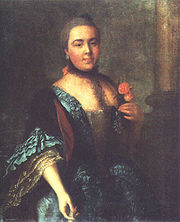
Elizaveta Vorontsova
Encyclopedia

Peter III of Russia
Peter III was Emperor of Russia for six months in 1762. He was very pro-Prussian, which made him an unpopular leader. He was supposedly assassinated as a result of a conspiracy led by his wife, who succeeded him to the throne as Catherine II.-Early life and character:Peter was born in Kiel, in...
. During their affair, Peter was rumored to have intentions of divorcing his wife Catherine
Catherine II of Russia
Catherine II, also known as Catherine the Great , Empress of Russia, was born in Stettin, Pomerania, Prussia on as Sophie Friederike Auguste von Anhalt-Zerbst-Dornburg...
(the future empress) to marry Vorontsova.
She belonged to the great Vorontsov
Vorontsov
Vorontsov, also Woronzow, Woroncow is a celebrated Russian family, which attained the dignity of Counts of the Holy Roman Empire in 1744 and Serene Princes of the Russian Empire in 1852....
family that reached the pinnacle of power during the last years of the reign of Empress Elizabeth, when Vorontsova's uncle Mikhail Illarionovich
Mikhail Illarionovich Vorontsov
Count Mikhail Illarionovich Vorontsov was a Russian statesman and diplomat, who laid foundations for the fortunes of the Vorontsov family....
served as Imperial
Russian Empire
The Russian Empire was a state that existed from 1721 until the Russian Revolution of 1917. It was the successor to the Tsardom of Russia and the predecessor of the Soviet Union...
Chancellor. Her father, General Roman Vorontsov, governed the provinces of Vladimir
Vladimir
Vladimir is a city and the administrative center of Vladimir Oblast, Russia, located on the Klyazma River, to the east of Moscow along the M7 motorway. Population:...
, Penza
Penza
-Honors:A minor planet, 3189 Penza, discovered by Soviet astronomer Nikolai Stepanovich Chernykh in 1978, is named after the city.-Notable residents:...
, Tambov
Tambov
Tambov is a city and the administrative center of Tambov Oblast, Russia, located at the confluence of the Tsna and Studenets Rivers southeast of Moscow...
, and Kostroma
Kostroma
Kostroma is a historic city and the administrative center of Kostroma Oblast, Russia. A part of the Golden Ring of Russian towns, it is located at the confluence of the Volga and Kostroma Rivers...
, where his name became a byword for graft and inefficiency
Following her mother's death in 1750, the child Elizaveta was attached to the Oranienbaum
Lomonosov, Russia
Lomonosov is a municipal town in Petrodvortsovy District of the federal city of St. Petersburg, Russia, situated on the southern coast of the Gulf of Finland, west of St. Petersburg proper. Population:...
court of Grand Duke Peter's wife, Grand Duchess Catherine Alekseyevna
Catherine II of Russia
Catherine II, also known as Catherine the Great , Empress of Russia, was born in Stettin, Pomerania, Prussia on as Sophie Friederike Auguste von Anhalt-Zerbst-Dornburg...
(at this time, Peter was the heir to the throne). By accounts, Elizaveta was a slob: She "swore like a soldier, squinted her eyes, smelled bad, and spit while talking". Baron de Breteuil
Louis Auguste Le Tonnelier de Breteuil
Louis Charles Auguste le Tonnelier, baron de Breteuil, baron de Preuilly was a French aristocrat, diplomat, statesman and politician...
compared her appearance to that of a "scullery maid of the lowliest kind". Catherine herself would write of her as "very ugly, extremely dirty child with an olive skin". Peter, however, developed a fondness for her, which the court was at a loss to explain. Catherine called Elizaveta a new Madame de Pompadour
Madame de Pompadour
Jeanne Antoinette Poisson, Marquise de Pompadour, also known as Madame de Pompadour was a member of the French court, and was the official chief mistress of Louis XV from 1745 to her death.-Biography:...
Sukhareva 2005 (of whom she greatly disapproved), while the Grand Duke took to calling her "my Romanova" (a pun on her patronymic, Romanovna: his own surname was Romanov).
After Elizaveta's lover became Emperor in January 1762, he invested her with the Order of Saint Catherine and had rooms prepared for her in the newly built Winter Palace
Winter Palace
The Winter Palace in Saint Petersburg, Russia, was, from 1732 to 1917, the official residence of the Russian monarchs. Situated between the Palace Embankment and the Palace Square, adjacent to the site of Peter the Great's original Winter Palace, the present and fourth Winter Palace was built and...
next to his own. She accompanied Peter in all his excursions and adventures, and foreign ambassadors reported to their governments that the Emperor was intending to banish his wife to a convent in order to marry Vorontsova. Controversy endures to the present day as to whether Catherine took any part in the deposal of Peter in July 1762 (after a reign of just six months) and his subsequent death three days later. There are those who argue that the aforementioned rumors drove Catherine to join efforts with Vorontsova's own sister, Princess Ekaterina Dashkova, and stage a palace revolution that removed her husband from power in July 1762.
Catherine II, in her memoirs, pulled no punches when discussing Vorontsova. In a letter from June 1762, she claimed that the Vorontsovs had made plans to shut her up in a cloister and put their relative on the throne. Although Vorontsova wished to follow her lover into exile in Holstein
Holstein
Holstein is the region between the rivers Elbe and Eider. It is part of Schleswig-Holstein, the northernmost state of Germany....
(his homeland), his sudden death put an end to this prospect.
The Empress then arranged her rival's marriage to an army colonel of humble background, and bade them to withdraw to the countryside. There Vorontsova spent the rest of her days in bitterness and ill health, while her brothers Alexander
Alexander Vorontsov
Count Alexander Romanovich Vorontsov was the Russian imperial chancellor during the early years of Alexander I's reign....
and Semyon
Semyon Romanovich Vorontsov
Count Semyon Romanovich Vorontsov was a Russian diplomat whose siblings included Alexander Vorontsov, Elizaveta Vorontsova, and Ekaterina Dashkova...
made spectacular careers in the diplomatic service.

